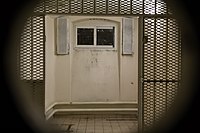
Photo from wikipedia
Incarceration, along with its most restrictive iteration, solitary confinement, is an increasingly common experience in America. More than two million Americans are currently incarcerated, and at least one-fifth of incarcerated… Click to show full abstract
Incarceration, along with its most restrictive iteration, solitary confinement, is an increasingly common experience in America. More than two million Americans are currently incarcerated, and at least one-fifth of incarcerated people will experience solitary confinement. Understanding the barriers to care people experience in prison, and especially in solitary confinement, is key to improving their access to care during and after incarceration. Drawing on in-depth qualitative interviews with a random sample of 106 people living in solitary confinement and a convenience sample of 77 people working in solitary confinement in Washington State, we identify two key barriers to care that people in solitary confinement face: cultural barriers (assumptions that incarcerated people do not need or do not deserve care) and structural barriers (physical spaces and policies that make contacting a healthcare provider difficult). While scholarship has documented both the negative health consequences of solitary confinement and correctional healthcare providers’ challenges navigating between the “dual loyalty” of patient care and security missions, especially within solitary confinement, few have documented the specific mechanisms by which people in solitary confinement are repeatedly triaged out of healthcare access. Understanding these barriers to care is critical not only to improving correctional healthcare delivery but also to improving healthcare access for millions of formerly incarcerated people who have likely had negative experiences seeking healthcare in prison, especially if they were in solitary confinement.
Journal Title: Healthcare
Year Published: 2022
Link to full text (if available)
Share on Social Media: Sign Up to like & get
recommendations!